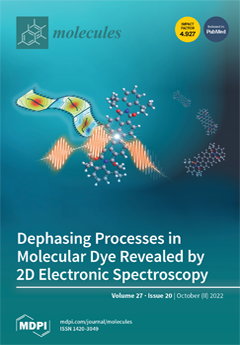Annona macroprophyllata Donn (
A. macroprophyllata) is used in traditional Mexican medicine for the treatment of cancer, diabetes, inflammation, and pain. In this work, we evaluated the antitumor activity of three acyclic terpenoids obtained from
A. macroprophyllata to assess their potential as
[...] Read more.
Annona macroprophyllata Donn (
A. macroprophyllata) is used in traditional Mexican medicine for the treatment of cancer, diabetes, inflammation, and pain. In this work, we evaluated the antitumor activity of three acyclic terpenoids obtained from
A. macroprophyllata to assess their potential as antilymphoma agents. We identified the terpenoids farnesyl acetate (FA), phytol (PT) and geranylgeraniol (Gg) using gas chromatography–mass spectroscopy (GC-MS) and spectroscopic (
1H, and
13C NMR) methods applied to petroleum ether extract of leaves from
A. macroprophyllata (PEAm). We investigated antitumor potential in Balb/c mice inoculated with U-937 cells by assessing brine shrimp lethality (BSL), and cytotoxic activity in these cells. In addition, to assess the potential toxicity of PEAm, FA, PT and Gg in humans, we tested their acute oral toxicity in mice. Our results showed that the three terpenoids exhibited considerable antilymphoma and cytotoxic activity. In terms of lethality, we determined a median lethal dose (LD
50) for thirteen isolated products of PEAm. Gg, PT and AF all exhibited a higher lethality with values of 1.41 ± 0.42, 3.03 ± 0.33 and 5.82 ± 0.58 µg mL
−1, respectively. To assess cytotoxic activity against U-937 cells, we calculated the mean cytotoxic concentration (CC
50) and found that FA and PT were closer in respect to the control drug methotrexate (MTX, 0.243 ± 0.007 µM). In terms of antilymphoma activity, we found that FA, PT and Gg considerably inhibited lymph node growth, with median effective doses (ED
50) of 5.89 ± 0.39, 6.71 ± 0.31 and 7.22 ± 0.51 mg kg
−1 in females and 5.09 ± 0.66, 5.83 ± 0.50 and 6.98 ± 0.57mg kg
−1 in males, respectively. Regarding acute oral toxicity, we classified all three terpenoids as category IV, indicating a high safety margin for human administration. Finally, in a molecular docking study of 3-hydroxy-3-methylglutaryl-coenzyme A (HMG-CoA) reductase, we found binding of terpenoids to some amino acids of the catalytic site, suggesting an effect upon activity with a resulting decrease in the synthesis of intermediates involved in the prenylation of proteins involved in cancer progression. Our findings suggest that the acyclic terpenoids FA, PT, and Gg may serve as scaffolds for the development of new treatments for non-Hodgkin’s lymphoma.
Full article






